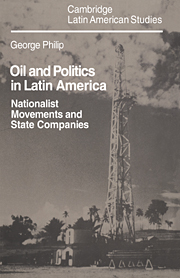Book contents
- Frontmatter
- Contents
- List of tables
- Preface
- Glossary
- Abbreviations
- Note on currencies and other units of measurement
- Maps: Latin America in 1920, 1940, 1960 and 1981; showing importing countries, exporting countries and countries self-sufficient in oil
- Introduction: The politics of oil in twentieth-century Latin America
- Part I The world oil environment
- 1 The corporate ascendancy 1890–1927
- 2 Retrenchment and concentration 1928–41
- 3 The making of the post-war oil world 1942–55
- 4 The major companies in retreat 1955–70
- 5 The oil market revolution and its consequences for Latin America 1971–9
- 6 Latin America in the twentieth-century oil system
- Part II The major expropriations
- Part III The state oil companies
- Notes and bibliography
- Index
- CAMBRIDGE LATIN AMERICAN STUDIES
2 - Retrenchment and concentration 1928–41
Published online by Cambridge University Press: 23 December 2009
- Frontmatter
- Contents
- List of tables
- Preface
- Glossary
- Abbreviations
- Note on currencies and other units of measurement
- Maps: Latin America in 1920, 1940, 1960 and 1981; showing importing countries, exporting countries and countries self-sufficient in oil
- Introduction: The politics of oil in twentieth-century Latin America
- Part I The world oil environment
- 1 The corporate ascendancy 1890–1927
- 2 Retrenchment and concentration 1928–41
- 3 The making of the post-war oil world 1942–55
- 4 The major companies in retreat 1955–70
- 5 The oil market revolution and its consequences for Latin America 1971–9
- 6 Latin America in the twentieth-century oil system
- Part II The major expropriations
- Part III The state oil companies
- Notes and bibliography
- Index
- CAMBRIDGE LATIN AMERICAN STUDIES
Summary
For Latin America, the 1920s was a decade of open, expanding, competitive capitalism of which foreign companies took full advantage. Nowhere was this more true than in the oil industry. While the expansion of the foreign oil companies was underpinned by the support of the us State Department and the British Foreign Office, it was certainly not based entirely, or even mainly, on coercion. Latin American elites generally welcomed the inflow of foreign oil investment in the hope of quick fortunes. The 1930s, however, were years of retrenchment and concentration; oil had become abundant and the industry became concerned to avoid the consequences of oversupply. Management rather than discovery became the key to oil company behaviour.
The 1930s was made up of two distinct periods. Until 1934, the slump led to a fall in demand and the companies cut back production wherever they could. After 1934, however, there was a partial recovery and production and profits picked up, but the market was still vulnerable and vertical integration remained essential to the position of the major companies. In the late 1930s, war appeared increasingly probable and strategic aspects of the international oil industry became more and more important, although these were by no means uniform in their effect.
Achnacarry and the slump 1928–34
For the oil industry, the pattern of the 1930s was largely shaped by the Achnacarry agreement of 1928, which was made by the major oil companies just before the depression but after it had become clear that the world market was in fundamental oversupply.
- Type
- Chapter
- Information
- Oil and Politics in Latin AmericaNationalist Movements and State Companies, pp. 43 - 60Publisher: Cambridge University PressPrint publication year: 1982



